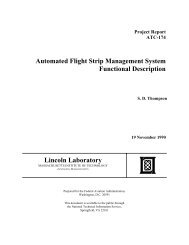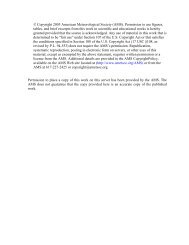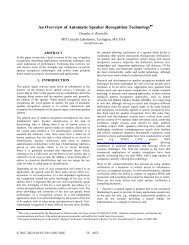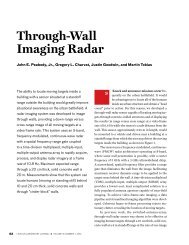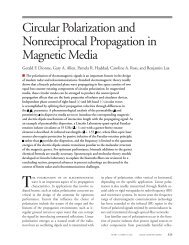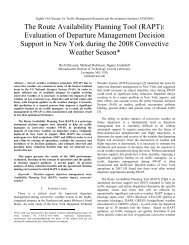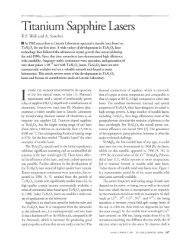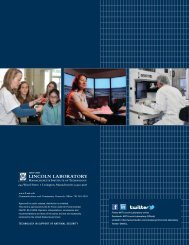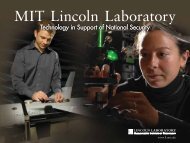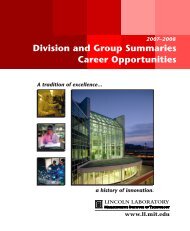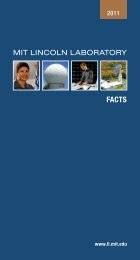Laser Development at Lincoln Laboratory - MIT Lincoln Laboratory
Laser Development at Lincoln Laboratory - MIT Lincoln Laboratory
Laser Development at Lincoln Laboratory - MIT Lincoln Laboratory
Create successful ePaper yourself
Turn your PDF publications into a flip-book with our unique Google optimized e-Paper software.
stabiliz<strong>at</strong>ion and mode-control techniques were applied<br />
to develop a tool for laser spectroscopy. In addition, the<br />
self-focusing effects oflaser beams in gases as well as in<br />
solids were studied both experimentally and theoretically.<br />
This research included collabor<strong>at</strong>ive efforts between<br />
<strong>Lincoln</strong> Labor<strong>at</strong>ory, the University of California <strong>at</strong><br />
Berkeley, and IBM [66, 67].<br />
Other topics of investig<strong>at</strong>ion in the 1970s were harmonic<br />
gener<strong>at</strong>ion and frequency mixing in nonlinear<br />
optical m<strong>at</strong>erials. High-quality ctyStals of the calcopyrites<br />
CdGeH 2 and HgGaSe were grown and used to<br />
frequency-double the 10.6-,um CO 2 emission. A conversion<br />
efficiency of nearly 30% was obtained for lidar<br />
experiments in the remote sensing of<strong>at</strong>mospheric constituents<br />
[68]. An extremely useful applic<strong>at</strong>ion of frequency<br />
conversion has resulted from the observ<strong>at</strong>ion<br />
th<strong>at</strong> the frequency sum oftwO Nd:YAG emission linesone<br />
<strong>at</strong> 1.06 ,urn and the other <strong>at</strong> 1.32 ,um--exaccly m<strong>at</strong>ch<br />
the sodium line <strong>at</strong> 0.59 ,urn. The cover photograph for<br />
this issue shows the yellow (0.59 ,urn) light beam formed<br />
by the sum-frequency mixing ofthe twO wavelengths of<br />
a Nd:YAG laser in a nonlinear crystal. The precise<br />
wavelength m<strong>at</strong>ch to the sodium resonance permits the<br />
probing of the earth's mesospheric <strong>at</strong>omic sodium layer<br />
in this experiment.<br />
In This Issue<br />
The articles in this issue provide a detailed description of<br />
some of <strong>Lincoln</strong> Labor<strong>at</strong>ory's accomplishments in the<br />
laser field during the past several years, including recent<br />
work in progress.<br />
In the diode laser area, ].P. Donnelly discusses the<br />
development ofincoherent high-power arrays for use as<br />
pump sources. The technologies for collim<strong>at</strong>ing the<br />
• MELNGAILIS<br />
<strong>Laser</strong> <strong>Development</strong> <strong>at</strong> <strong>Lincoln</strong> Labor<strong>at</strong>ory<br />
output of array elements by means of microlenses and<br />
some initial <strong>at</strong>tempts <strong>at</strong> establishing coherence among<br />
the elements are described by Z.L. Liau, V. Diadiuk,<br />
and ].N. Walpole. H.K. Choi, c.A. Wang, and S.].<br />
Eglash discuss two very recent advances in diode laser<br />
technology: the achievement ofrecord low thresholds in<br />
strained-layer InGaAs lasers, and the development of<br />
efficient room-temper<strong>at</strong>ure 2.3-,um GaInAsSb lasers.<br />
Two articles are devoted to the use ofdiode lasers as<br />
pump sources for ionic solid st<strong>at</strong>e lasers. TY. Fan's article<br />
primarily covers high-power devices, and J.J. Zayhowski's<br />
article describes the microchip laser, a low-power<br />
device th<strong>at</strong> achieves stable single-frequency oper<strong>at</strong>ion in<br />
a simple and inexpensive structure.<br />
In the area of broadly tunable solid st<strong>at</strong>e lasers, an<br />
article by K.F. Wall and A. Sanchez deals with the<br />
invention and development of the Ti:Al 2 0 3 laser. Finally,<br />
techniques for stabilizing and controlling laser<br />
Output spectra for applic<strong>at</strong>ions in laser radars are covered<br />
by P.A. Schulz and C. Freed. Schulz's article describes<br />
the frequency control and wavelength tuning of solid<br />
st<strong>at</strong>e lasers and Freed's article deals with the develop<br />
ment of ultrastable CO 2 lasers.<br />
Acknowledgments<br />
The contributions made by <strong>Lincoln</strong> Labor<strong>at</strong>ory during<br />
the past 28 years to the science and technology oflasers<br />
constitute the work ofa large number ofstaff members<br />
whose names are found in the references. The writing of<br />
this historical review was facilit<strong>at</strong>ed by the existence of<br />
two earlier review articles by P.L. Kelley [1] and R.H.<br />
Rediker et al. [2] and by valuable editorial comments<br />
and suggestions from Alan McWhorter and Aram<br />
Mooradian.<br />
VOLUME 3. NUMBER 3. 1990 THE LINCOLN LABORATORY JOURNAL 357




